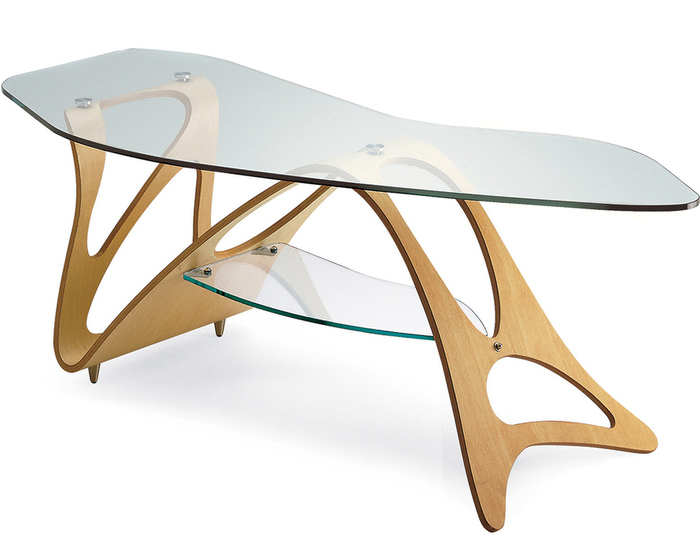arabesco coffee table
by Carlo Mollino from Zanotta
arabesco coffee table
Design Carlo Mollino, 1949
Bent plywood, tempered plate glass, stainless steel
Made in Italy by Zanotta
Arabesco table was originally designed by Mollino in 1949 for the living room of Casa Orenga in Turin. In designing this piece, Mollino started to see pieces of furniture as autonomous objects, incorporating erotic associations into his furniture desings, rather than architectural elements. It is said that the unique look of the tabletop takes its form from the rear-view perspective in Reclining Nude, a drawing by Léonor Fini. Also, the table frame is said to reference Surrealist motifs by Salvador Dali and Jean Arp.
His friends called him "Carlo il Bizarro." Architect Carlo Mollino was always attempting to escape the monotony of the everyday working world. He occupied himself in numerous activities outside his profession like photography, race cars, fashion design, composed essays and also did architecture. Throughout his career, Mollino acquired numerous patents for concrete honeycomb constructions, tubular steel joints, and molded plywood elements, inventing devices for creating perspective drawings, streamlined race car bodies, automatic drift correction instruments for airplanes, and improved chain and sprocket drives for bicycles. His works have won numerous awards as well as being showcased in museums around the globe.
The Arabesco Table features a bent plywood frame veneered with natural or black varnished oak. The frame is fastened to the top with an internally threaded screw. The glass top is .4" thick tempered plate glass and the bottom shelf is .3" thick tempered plate glass. The natural oak frame comes with extra-clear glass while the black varnished oak frame comes with smokey grey plate glass.
50.8" w | 20.9" d | 17.7" h | glass top: .4" thick | lower glass shelf: .3" thick
Bent plywood, tempered plate glass, stainless steel
Made in Italy by Zanotta
Arabesco table was originally designed by Mollino in 1949 for the living room of Casa Orenga in Turin. In designing this piece, Mollino started to see pieces of furniture as autonomous objects, incorporating erotic associations into his furniture desings, rather than architectural elements. It is said that the unique look of the tabletop takes its form from the rear-view perspective in Reclining Nude, a drawing by Léonor Fini. Also, the table frame is said to reference Surrealist motifs by Salvador Dali and Jean Arp.
His friends called him "Carlo il Bizarro." Architect Carlo Mollino was always attempting to escape the monotony of the everyday working world. He occupied himself in numerous activities outside his profession like photography, race cars, fashion design, composed essays and also did architecture. Throughout his career, Mollino acquired numerous patents for concrete honeycomb constructions, tubular steel joints, and molded plywood elements, inventing devices for creating perspective drawings, streamlined race car bodies, automatic drift correction instruments for airplanes, and improved chain and sprocket drives for bicycles. His works have won numerous awards as well as being showcased in museums around the globe.
The Arabesco Table features a bent plywood frame veneered with natural or black varnished oak. The frame is fastened to the top with an internally threaded screw. The glass top is .4" thick tempered plate glass and the bottom shelf is .3" thick tempered plate glass. The natural oak frame comes with extra-clear glass while the black varnished oak frame comes with smokey grey plate glass.
50.8" w | 20.9" d | 17.7" h | glass top: .4" thick | lower glass shelf: .3" thick
Carlo Mollino
Carlo Mollino began his career as an architect and moved into other disciplines. He infused his loves of skiing, race car driving and the occult. He died of an unexpected heart-attack in 1973.
Zanotta is one of the recognized leaders in Italian industrial design. Guided by the insight and wonderful entrepreneurship abilities of the founder, Aureilio Zanotta, beginning in the 1960s it won and has held the international spotlight. This was thanks to its products: emblematic for both their formal and technological innovations.





 write a review now
write a review now
